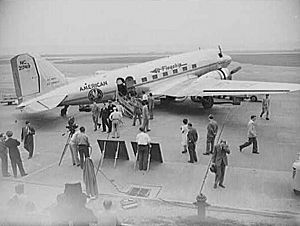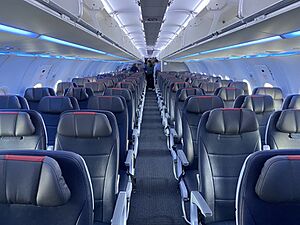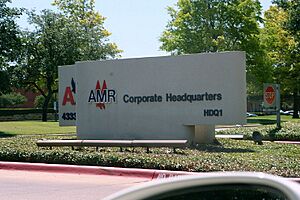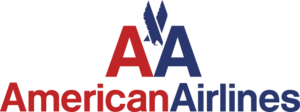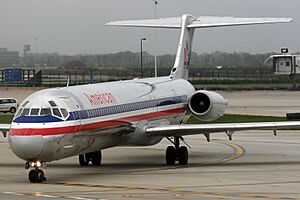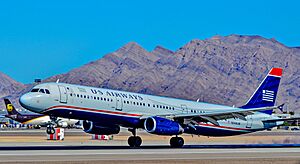American Airlines facts for kids
An American Airlines Boeing 777-300ER
|
|
| Founded | April 15, 1926 (as American Airways, Inc.) |
|---|---|
| Commenced operations | June 25, 1936 |
| AOC # | AALA025A |
| Hubs | |
| Frequent-flyer program | AAdvantage |
| Alliance | Oneworld |
| Fleet size | 995 |
| Destinations | 353 |
| Parent company | American Airlines Group |
| Headquarters | Fort Worth, Texas, U.S. |
| Key people | |
| Revenue | |
| Operating income | |
| Net income | |
| Total assets | |
| Total equity | |
| Employees | 103,440 (2024) |
| Website | aa.com |
American Airlines, Inc. is a very large airline in the United States. Its main office is in Fort Worth, Texas. It is one of the biggest airlines in the world. It carries the most passengers and has the most daily flights.
American Airlines and its smaller partner airlines, called American Eagle, fly to many places. They have almost 6,800 flights every day. They reach nearly 350 cities in 48 countries. American Airlines is also a founding member of Oneworld. This is one of the world's three main groups of airlines.
American Airlines and American Eagle use ten main airports as their "hubs." A hub is a central airport where many flights connect. The biggest hub is Dallas/Fort Worth International Airport (DFW). The airline serves over 200 million passengers each year. This means more than 500,000 people fly with them every day. In 2024, the company had 103,440 employees.
Contents
History of American Airlines
American Airlines started in 1930. It was formed by joining more than eighty smaller airlines. Two important airlines that became part of American Airlines were Robertson Aircraft Corporation and Colonial Air Transport. These companies joined together in 1929. In 1930, they became one operating company called American Airways.
In 1934, new rules made many airlines change how they worked. American Airways then organized its flight paths into one connected system. It was renamed American Airlines. The airline grew its international flights between 1970 and 2000. It bought Trans World Airlines in 2001.
American Airlines helped create the Douglas DC-3 airplane. The CEO of American Airlines, C. R. Smith, asked Douglas Aircraft Company to design a new plane. He wanted a plane that could carry sleeping passengers. Douglas agreed to build it after American Airlines promised to buy 20 planes. The first test flight of this new plane was on December 17, 1935. This was the same date the Wright Brothers first flew. American Airlines started passenger flights with the DC-3 on June 26, 1936.
American Airlines also helped develop the DC-10 airplane. In 1966, American Airlines asked plane makers for a wide-body aircraft. They wanted one smaller than the Boeing 747. It still needed to fly long distances from airports with shorter runways. McDonnell Douglas created the DC-10. American Airlines ordered 25 DC-10s. The DC-10 first flew on August 29, 1970. It began flying for American Airlines on August 5, 1971. Its first trip was between Los Angeles and Chicago.
In 2011, American Airlines' parent company, the AMR Corporation, faced money problems. They filed for bankruptcy protection. In 2013, American Airlines joined with US Airways. They kept the American Airlines name because it was better known around the world. This merger created the largest airline in the United States, and then the world.
In December 2023, the company was added to the Dow Jones Sustainability World Index. This index includes companies that are considered good for the environment and society.
Where American Airlines Flies
Destinations
American Airlines flies to many places around the world. This includes cities in North America, South America, Europe, Asia, and Australia. They also fly to many islands in the Caribbean.
Hub Airports

American Airlines uses ten main airports as its hubs. These are like central stations where many flights connect.
- Charlotte: This hub is important for flights to the southeastern United States and the Caribbean.
- Chicago–O'Hare: This is American's hub for the Midwest region of the U.S.
- Dallas/Fort Worth: This is American's largest hub overall. It serves the southern United States.
- Los Angeles: This hub is for the West Coast. It also connects to flights across the Pacific Ocean.
- Miami: This is American's main hub for flights to Latin America and the Caribbean.
- New York–JFK: This hub is for flights across the Atlantic Ocean, especially to places popular with New York travelers.
- New York–LaGuardia: This New York hub is mostly for flights within the United States.
- Philadelphia: This is American's main hub for flights across the Atlantic Ocean.
- Phoenix–Sky Harbor: This hub serves the southwestern United States.
- Washington–National: This hub is for flights to and from the capital of the United States.
American Eagle
Airline Partnerships
American Airlines is part of the Oneworld alliance. An alliance is a group of airlines that work together. This means they share flights and offer benefits to each other's passengers. American also has agreements with other airlines called "codeshares." This means you can buy a ticket from American Airlines, but fly on a plane operated by another airline.
Here are some airlines American Airlines partners with:
- Aer Lingus
- Air Tahiti Nui
- Alaska Airlines
- British Airways
- Cape Air
- Cathay Pacific
- China Southern Airlines
- Etihad Airways
- Finnair
- Fiji Airways
- Gol Linhas Aéreas Inteligentes
- Hawaiian Airlines
- Iberia
- IndiGo
- Japan Airlines
- JetSmart
- LAM Mozambique Airlines
- Malaysia Airlines
- Philippine Airlines
- Qantas
- Qatar Airways
- Royal Air Maroc
- Royal Jordanian
- SriLankan Airlines
Joint Ventures
American Airlines has special partnerships called "joint ventures" with some Oneworld members. These are more than just codeshares. They plan routes, schedules, and share money from flights together.
- The Atlantic Joint Business covers flights across the Atlantic Ocean with Aer Lingus, British Airways, Finnair, and Iberia.
- The Pacific Joint Business covers flights across the Pacific Ocean with Japan Airlines.
- Another joint venture with Qantas covers flights between the United States, Australia, and New Zealand.
Types of Seats (Cabins)
American Airlines offers different types of seating, called "cabins," on its planes. These range from very fancy to more basic.
- Flagship First
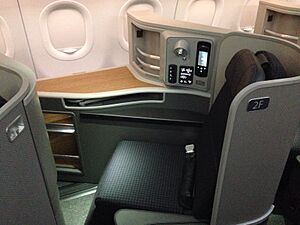
Flagship First is American's top-level first class. It's for international flights and long flights across the U.S. (like New York to Los Angeles). These seats are very comfortable and can lie completely flat. Each seat has direct access to the aisle. Passengers get special food, drinks, and access to airport lounges.
- Flagship Business

Flagship Business is American's business class for international and long U.S. flights. These seats also lie completely flat. Passengers get free drinks, multi-course meals, and lounge access.
- First and Business (Domestic)
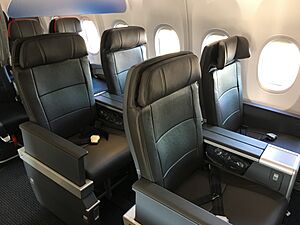
On flights within the U.S., American offers a First class. When these planes are used for international flights, this cabin is called Business class. These seats are wider and have more legroom than economy seats. Passengers get free drinks and snacks. On longer flights, they also get meals.
- Premium Economy
Premium Economy is a step up from regular economy. It's available on larger planes. These seats are wider and offer more space. Passengers get two free checked bags, priority boarding (meaning they get on the plane sooner), and better food and drink service, including free alcohol. American Airlines was the first U.S. airline to offer this four-cabin setup.
- Main Cabin
Main Cabin is American's standard economy class. It's on all of their planes. Seats are usually 17 to 18.5 inches wide. Some rows in the Main Cabin are called "Main Cabin Preferred." You can pay extra to choose these seats.
- Main Cabin Extra
Main Cabin Extra seats are in the front rows and exit rows of the economy cabin. They have more legroom. Passengers also get free alcoholic drinks and can board the plane earlier than Main Cabin passengers.
- Basic Economy
Basic Economy is American's lowest-priced ticket. It comes with more rules. For example, you might not get to choose your seat until you check in. These tickets usually can't be changed or refunded. Basic Economy passengers board the plane last.
In 2017, American Airlines added more seats to some of its planes, like the Boeing 737 MAX 8. This meant less legroom in some economy seats. This change, called "Project Oasis," has been put into many planes. Some passengers, especially frequent flyers, do not like these new seats because they have less padding and no screens on the seatbacks.
Loyalty Programs
AAdvantage
AAdvantage is American Airlines' program for frequent flyers. It started on May 1, 1981. It is the largest program of its kind, with over 115 million members in 2021. Members earn "miles" when they fly. They can use these miles for free tickets, seat upgrades, or discounts on car rentals and hotel stays.
Members who fly a lot can become "elite" members. These levels are AAdvantage Gold, Platinum, Platinum Pro, and Executive Platinum. Elite members get special benefits like faster check-in, priority for upgrades, and other perks. Their status also works with American's Oneworld partner airlines.
American Airlines also offers AAdvantage credit cards. These cards give members more benefits.
Admirals Club
The Admirals Club is a special lounge at the airport for American Airlines' best customers. It was started in 1939 by American Airlines president C.R. Smith. He wanted to make important passengers feel special.
The first Admirals Club opened at LaGuardia Airport in New York. Later, another opened at Washington National Airport. For many years, you could only join the Admirals Club if the airline invited you. But in 1974, it became a paid membership program.
Flagship Lounge
The Flagship Lounge is a separate, even more exclusive lounge. It is for passengers flying in Flagship First and Flagship Business class on international and long U.S. flights. It offers a higher level of service than the Admirals Club.
Company Information
Business Trends
Here's a look at how American Airlines has been doing financially:
| Revenue (US$ m) |
Net income (US$ m) |
Number of employees (FTE, k) |
Passenger enplanements (m) |
Passenger load factor (%) |
Fleet size | References | |
|---|---|---|---|---|---|---|---|
| 2015 | 40,990 | 7,610 | 99 | 201 | 83.0 | 946 | |
| 2016 | 40,142 | 2,676 | 101 | 198 | 81.7 | 930 | |
| 2017 | 42,622 | 1,919 | 103 | 194 | 81.9 | 948 | |
| 2018 | 44,541 | 1,412 | 102 | 203 | 82.0 | 956 | |
| 2019 | 45,768 | 1,686 | 104 | 215 | 84.6 | 942 | |
| 2020 | 17,337 | −8,885 | 78 | 95 | 64.1 | 855 | |
| 2021 | 29,882 | −1,993 | 97 | 165 | 75.3 | 865 | |
| 2022 | 48,971 | 127 | 102 | 199 | 82.9 | 925 | |
| 2023 | 52,788 | 822 | 103 | 210 | 83.5 | 965 | |
| 2024 | 54,211 | 846 | 103 | 226 | 84.9 | 977 |
Headquarters
American Airlines' main office is in Fort Worth, Texas. It's called the "Robert L. Crandall Campus." This campus has five office buildings and is very large. It is located near Dallas/Fort Worth International Airport, which is American's biggest hub.
Before moving to Texas, American Airlines was based in New York City. In 1979, they moved their headquarters to Fort Worth. In 2015, American announced plans to build a new headquarters in Fort Worth. Construction started in 2016 and was finished in September 2019. The new building can hold 5,000 new employees.
Company Look (Corporate Identity)
Logo
In 1931, an American Airlines employee designed the first AA logo. It featured an eagle. In 1967, the logo was redesigned by Massimo Vignelli. American Airlines later bought the website address AA.com. "AA" is also the airline's two-letter code.
On January 17, 2013, American Airlines launched a new logo and marketing campaign. The new logo includes parts of the 1967 design.
Aircraft Livery (Paint Scheme)
For many years, American Airlines planes had a special look. Most of their planes were left unpainted, showing the shiny metal. This was because a former CEO, C. R. Smith, didn't like painted planes. Another CEO, Robert Crandall, said that less paint made the planes lighter, saving fuel.
On January 17, 2013, American Airlines showed off a new paint scheme for its planes. This new design has an abstract American flag on the tail. The main part of the plane is still silver, like a nod to the old look.
After American Airlines merged with US Airways, employees voted on which paint scheme to keep. They chose to keep the new look. American Airlines also decided to keep some planes painted in the old styles of airlines that merged with them, like US Airways and TWA.
Employee Relations
Different groups of American Airlines employees have unions that represent them:
- The Allied Pilots Association represents American Airlines pilots.
- The Association of Professional Flight Attendants represents American Airlines flight attendants.
- Flight attendants at the smaller regional airlines (Envoy, Piedmont, and PSA) are represented by the Association of Flight Attendants – Communications Workers of America (AFA-CWA).
- The Transport Workers Union-International Association of Machinists alliance (TWU-IAM) represents most of the ground workers and mechanics.
- Customer service and gate employees belong to the Communications Workers of America/International Brotherhood of Teamsters Passenger Service Association.
- PAFCA-AAL represents the Aircraft Dispatchers. These are specialists who share responsibility with the pilot for the safety of each flight.
Subsidiary Companies
Sky Chefs
In 1942, American Airlines started Sky Chefs. This company provided food for their planes. In 1986, Sky Chefs was sold.
Americana Hotels
In the late 1960s, American Airlines also started a hotel chain called Flagship Hotels. In 1972, they leased more hotels and renamed the whole chain Americana Hotels. American Airlines sold Americana Hotels in 1980.
Important Issues
Lifetime AAirpass
In 1981, American Airlines offered a special "lifetime pass" for unlimited travel. It cost $250,000. Twenty-eight people bought these passes. However, the airline later realized these passes were costing them a lot of money. Some pass holders flew very often, even for short trips or multiple times a month to other countries. American Airlines raised the price to $3 million and then stopped offering it in 2003. They even canceled two passes, saying there was "fraudulent activity."
Cabin Fume Events
Sometimes, strange odors or fumes can appear in airplane cabins. This can be a safety concern for passengers and crew.
- In 1988, on American Airlines Flight 132, smoke was reported in the cabin. The crew did not immediately realize how serious it was.
- In 2007, on American Airlines Flight 843, toxic fumes leaked into the cabin. A flight attendant later sued, saying she got sick from the fumes.
- In 2017, on American Airlines Flight 1896, seven flight attendants were hospitalized after a strange odor. This plane had similar issues before.
- In 2018, flight attendants protested about sick days. They mentioned concerns about toxic cabin air and other issues making them sick.
- In 2019, two pilots and three flight attendants on Flight 1897 were hospitalized after a strange odor.
Discrimination Complaints
In 2017, the NAACP (a civil rights organization) advised African Americans to be careful when flying with American Airlines. This was after four incidents where they felt passengers were treated unfairly. For example, a Black woman was moved from first class to coach, but her white friend was allowed to stay. The NAACP said that most of their complaints about airlines that year were about American Airlines. In 2018, the NAACP lifted its advisory, saying American Airlines had made improvements.
Accidents and Incidents
Like all airlines, American Airlines has had some accidents and incidents over its long history. These events are carefully investigated to learn from them and improve safety in air travel.
Environmental Impact
American Airlines tracks its carbon dioxide emissions. In 2020, their emissions were much lower due to less travel during the COVID-19 pandemic. However, they have increased again since then. The company aims to have "net zero" carbon emissions by 2050. This means they want to remove as much carbon from the air as they put into it.
In 2023, American Airlines bought "carbon credits" from a company called Graphyte. These credits help remove carbon dioxide from the air. Graphyte does this by compressing plant waste into bricks and storing them underground.
Climate Change Effects
Climate change can affect how airlines operate. Extreme weather events, like very hot temperatures, can make it harder for planes to take off. This is because hot air is less dense. This means planes might need to burn more fuel or carry less weight. This can affect both the airline's profits and the environment. Some studies suggest that by 2050, many flights during the hottest parts of the day might not be able to carry their full weight.
Images for kids
See also
 In Spanish: American Airlines para niños
In Spanish: American Airlines para niños
- AAirpass
- Air transportation in the United States
- List of airlines of the United States
- List of airports in the United States
- US Airways, which merged with American Airlines in 2015


